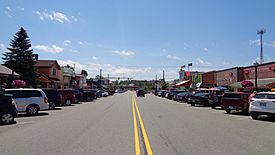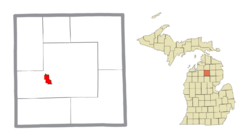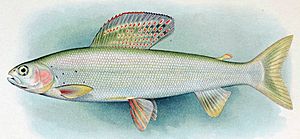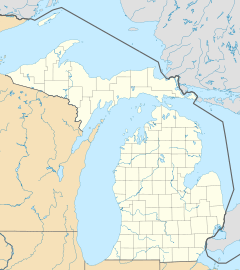Grayling, Michigan facts for kids
Quick facts for kids
Grayling, Michigan
|
|
|---|---|
| City of Grayling | |

Michigan Avenue facing I-75 BL / M-72
|
|

Location within Crawford County
|
|
| Country | United States |
| State | Michigan |
| County | Crawford |
| Founded | 1872 |
| Government | |
| • Type | Mayor–council |
| Area | |
| • Total | 2.08 sq mi (5.39 km2) |
| • Land | 2.05 sq mi (5.31 km2) |
| • Water | 0.03 sq mi (0.08 km2) |
| Elevation | 1,138 ft (347 m) |
| Population
(2020)
|
|
| • Total | 1,867 |
| • Density | 910.73/sq mi (351.71/km2) |
| Time zone | UTC-5 (Eastern (EST)) |
| • Summer (DST) | UTC-4 (EDT) |
| ZIP code(s) |
49738, 49739
|
| Area code(s) | 989 |
| FIPS code | 26-34640 |
| GNIS feature ID | 0627264 |
Grayling (pronounced GRAY-ling) is a city in Michigan, USA. It is the main town in Crawford County. In 2020, about 1,867 people lived there. Grayling is surrounded by Grayling Charter Township, but they are separate towns.
The city is in the middle of Northern Michigan. It is where major roads like Interstate 75 and U.S. Route 127 meet. Grayling is famous for the Au Sable River Canoe Marathon. This race happens every July since 1947. The city got its name from the grayling fish. These fish used to be common in the Au Sable River. However, they disappeared from Michigan by 1936. People have tried to bring them back, but it has not worked yet.
Contents
History of Grayling
Michael Shoat Hartwick was the first person to settle in Grayling. He built a log hotel on the west side of the railroad tracks. The railroad company planned out 40 acres for the town. They called it "Crawford." People saw many grayling fish in the river. They liked the name "Grayling" better than "Crawford." So, they renamed the area after the fish.
Grayling was important during the lumber era. It had access to two big rivers: the Au Sable River and the Manistee River. There were also huge forests nearby. Logs were floated down these rivers to the lakes.
Grayling had other names over the years. It was called "AuSable," "Forest," and "Crawford Station." During the time of lumbering, it was known as "Milltown."

The Arctic grayling fish used to live all over Northern Michigan. But they eventually disappeared. Logging practices hurt their breeding grounds. When logs were moved down rivers in spring, it damaged the fish habitats. Then, in the 1890s, new fish like brook trout were brought in. These new fish competed with the grayling for food. This also led to the grayling's disappearance.
The Grayling Fish Hatchery was started in 1914. A rich timber businessman named Rasmus Hanson built it. He hoped to bring the grayling fish back to the Au Sable River. It is interesting because logging, which made him rich, also destroyed the fish's home. Other famous people helped pay for the hatchery. These included Henry Ford, Edsel Ford, and Thomas Edison. Even with these efforts, the grayling fish became extinct in Michigan.
However, the hatchery still helped with nature conservation. In 1926, the state of Michigan bought it. It kept working as a fish hatchery and a place for tourists. This continued until the mid-1960s. In 1995, Michigan sold the land to Crawford County. Now, a private fish farm runs it. It is still open to the public during the summer.
Rasmus Hanson was a very important person in Grayling's history. He was born in Denmark in 1846. He moved to the United States later. At age 16, he started working with lumber. Two years later, he helped start the Salling-Hanson Company. This company closed in 1927 after almost 50 years. Hanson was a successful businessman. He started many businesses in Northern Michigan. He also owned the Michigan Sugar Company.
In 1916, he gave 13,826 acres of land to Michigan. This land was used as a forest game preserve. It also became a military training area. This was the first state-owned game preserve. The area south of Lake Margrethe is still used by the National Guard. This base serves guards from Michigan, Ohio, and Indiana. Lake Margrethe was named after Hanson's wife, Margrethe.
Since 1947, Grayling has been the start of the Au Sable River Canoe Marathon. This race happens every year in late July. It is the longest nonstop canoe race in North America.
Geography of Grayling
Grayling covers about 2.04 square miles (5.28 km2) of land. Most of it is land, and a small part is water.
- The middle part of the Au Sable River flows through the city.
- Lake Margrethe is close to the city.
- Hartwick Pines State Park is about 7 miles (11 km) north of Grayling.
- The Huron part of the Huron-Manistee National Forests is to the east.
- North Down River Road is east of the city. It runs along the Au Sable River. This road is a special National Scenic Byway. It goes for 23 miles (37 km) to Oscoda. The Lumberman's Monument is on this byway.
- An oilfield is located about 4 miles (6.4 km) south of the city.
Grayling's Climate
Grayling has big temperature changes throughout the year. Summers are warm to hot and often humid. Winters are cold, sometimes very cold. This type of weather is called a humid continental climate.
| Climate data for Grayling, Michigan, 1991–2020 normals, extremes 1891–present | |||||||||||||
|---|---|---|---|---|---|---|---|---|---|---|---|---|---|
| Month | Jan | Feb | Mar | Apr | May | Jun | Jul | Aug | Sep | Oct | Nov | Dec | Year |
| Record high °F (°C) | 57 (14) |
63 (17) |
85 (29) |
89 (32) |
98 (37) |
103 (39) |
104 (40) |
102 (39) |
101 (38) |
87 (31) |
75 (24) |
64 (18) |
104 (40) |
| Mean maximum °F (°C) | 44.3 (6.8) |
47.2 (8.4) |
60.9 (16.1) |
74.8 (23.8) |
85.5 (29.7) |
90.3 (32.4) |
90.9 (32.7) |
89.5 (31.9) |
85.9 (29.9) |
76.7 (24.8) |
61.7 (16.5) |
48.7 (9.3) |
93.6 (34.2) |
| Mean daily maximum °F (°C) | 26.0 (−3.3) |
28.7 (−1.8) |
39.4 (4.1) |
52.8 (11.6) |
67.0 (19.4) |
76.6 (24.8) |
80.2 (26.8) |
78.5 (25.8) |
70.7 (21.5) |
56.6 (13.7) |
42.7 (5.9) |
31.5 (−0.3) |
54.2 (12.3) |
| Daily mean °F (°C) | 17.8 (−7.9) |
18.7 (−7.4) |
27.9 (−2.3) |
40.8 (4.9) |
53.8 (12.1) |
63.7 (17.6) |
67.6 (19.8) |
66.0 (18.9) |
58.0 (14.4) |
46.0 (7.8) |
34.4 (1.3) |
24.6 (−4.1) |
43.3 (6.3) |
| Mean daily minimum °F (°C) | 9.7 (−12.4) |
8.7 (−12.9) |
16.4 (−8.7) |
28.8 (−1.8) |
40.7 (4.8) |
50.8 (10.4) |
55.1 (12.8) |
53.4 (11.9) |
45.3 (7.4) |
35.4 (1.9) |
26.2 (−3.2) |
17.7 (−7.9) |
32.3 (0.2) |
| Mean minimum °F (°C) | −15.6 (−26.4) |
−15.7 (−26.5) |
−8.5 (−22.5) |
12.2 (−11.0) |
24.8 (−4.0) |
34.9 (1.6) |
41.7 (5.4) |
38.5 (3.6) |
30.6 (−0.8) |
21.4 (−5.9) |
8.7 (−12.9) |
−4.0 (−20.0) |
−21.3 (−29.6) |
| Record low °F (°C) | −34 (−37) |
−42 (−41) |
−38 (−39) |
−12 (−24) |
14 (−10) |
23 (−5) |
28 (−2) |
26 (−3) |
16 (−9) |
7 (−14) |
−9 (−23) |
−28 (−33) |
−42 (−41) |
| Average precipitation inches (mm) | 1.82 (46) |
1.39 (35) |
1.68 (43) |
3.39 (86) |
3.23 (82) |
3.64 (92) |
3.07 (78) |
3.26 (83) |
3.22 (82) |
4.01 (102) |
2.58 (66) |
1.95 (50) |
33.24 (845) |
| Average snowfall inches (cm) | 25.8 (66) |
18.9 (48) |
10.8 (27) |
4.2 (11) |
0.1 (0.25) |
0.0 (0.0) |
0.0 (0.0) |
0.0 (0.0) |
0.0 (0.0) |
1.4 (3.6) |
6.9 (18) |
20.2 (51) |
88.3 (224.85) |
| Average precipitation days (≥ 0.01 in) | 18.6 | 13.8 | 11.6 | 12.3 | 13.6 | 12.5 | 12.0 | 12.4 | 13.7 | 17.4 | 16.0 | 17.4 | 171.3 |
| Average snowy days (≥ 0.1 in) | 14.3 | 10.5 | 6.2 | 2.1 | 0.2 | 0.0 | 0.0 | 0.0 | 0.0 | 0.9 | 4.9 | 11.4 | 50.5 |
| Source: NOAA | |||||||||||||
People of Grayling
| Historical population | |||
|---|---|---|---|
| Census | Pop. | %± | |
| 1910 | 1,775 | — | |
| 1920 | 2,450 | 38.0% | |
| 1930 | 1,973 | −19.5% | |
| 1940 | 2,124 | 7.7% | |
| 1950 | 2,066 | −2.7% | |
| 1960 | 2,015 | −2.5% | |
| 1970 | 2,143 | 6.4% | |
| 1980 | 1,792 | −16.4% | |
| 1990 | 1,944 | 8.5% | |
| 2000 | 1,952 | 0.4% | |
| 2010 | 1,884 | −3.5% | |
| 2020 | 1,867 | −0.9% | |
| U.S. Decennial Census | |||
In 2010, there were 1,884 people living in Grayling. There were 764 households. About 419 of these were families. The city had about 937 people per square mile.
Most people in Grayling were White (97.2%). A small number were African American (0.7%), Native American (0.5%), or Asian (0.5%). About 1.7% of the population was Hispanic or Latino.
About 29.8% of households had children under 18. About 32.9% were married couples. The average household had 2.27 people. The average family had 3.00 people.
The average age in Grayling was 38.6 years. About 23.8% of residents were under 18. About 20.7% were 65 or older. There were slightly more females (53.3%) than males (46.7%).
Arts and Culture in Grayling
Grayling is proud of its history. It has saved old buildings and uses them for historical events. These events sometimes include reenactments.
- Crawford County Historical Museum: This museum is in the old railroad station downtown. It shows what life was like in the 1800s and 1900s. It focuses on the lumbering time. The community saved the station from being torn down. The museum grounds also have an old train car. There is a military building for Camp Grayling and local veterans. You can also see a trapper's cabin and an old fire station.
- Wellington Farm Park: This is a 60-acre living history museum. It shows farm life during the Great Depression. Many farm tasks are done daily using old tools and methods. The park has many historical buildings. These include a blacksmith shop, a farm market, and a sawmill. There is also a nature trail. The farm hosts several events in summer and fall. These include "Dairy Days" and a "Tractor & Engine Show." The farm is located west of I-75 on Military Road.
- Lake Margrethe: This lake is a big attraction for Camp Grayling. It was named after Rasmus Hanson's wife, Margrethe. Soldiers enjoy fishing and relaxing here. Local residents, campers, and tourists also use the lake. There is a state forest campground on its northwest side.
- Au Sable River Canoe Marathon: Grayling is the starting point for this famous race. It covers 120 miles (190 km) from Grayling to Oscoda. It is one of the longest canoe races in North America. The race is always held during the town's annual AuSable River Festival.
- Hartwick Pines State Park: This park has one of the last old-growth eastern white pine forests. It hosts events all year. A popular winter event is "cross country skiing by lantern light."
- Kirtland Center for the Performing Arts: This center is at Kirtland Community College in Roscommon, Michigan. It hosts many performers. This includes the famous comedy group The Second City.
- Grayling Hospital History: The first Grayling Hospital was built in 1884. It had 40 beds. It burned down in 1886. In 1911, the Sisters of Mercy opened Mercy Hospital. It was built by lumber barons to honor lumbermen. This hospital had 30 beds and operated for 48 years. A new hospital was built in 1956 and finished in 1958. In 2015, the hospital was sold. Its name changed to Munson Healthcare Grayling Hospital.
Parks and Recreation in Grayling
Grayling is known as the "Canoe Capital of the World." Several canoe rental places operate on the Au Sable River. These include Carlisle's Canoe and Penrods Resort. The Manistee River is also west of Grayling.
- Cross-country Skiing: Grayling is great for cross-country skiing. It has two top-rated places: Hartwick Pines State Park Trails and Mason Tract Pathway. Forbush Corners, nearby in Frederic, Michigan, is a famous training center. It gets early and late snow because of its special climate.
- Fishing: The grayling fish are gone, but other fish remain. You can find rainbow trout, brook trout, and brown trout. Grayling is a popular spot for fly fishing. It is near world-class streams, rivers, and lakes. The Au Sable River flows east to Lake Huron. The Manistee River flows west to Lake Michigan. Both rivers have many trout.
- Hunting: White-tailed deer hunting is very popular in Michigan. November 15 is a big day for deer hunting. About 70% of Crawford County is public land. This makes it a popular place for hunting.
- Winter Sports: Snow shoeing and snow mobile riding are popular activities. The local weather and land are perfect for them.
- Hanson Hills: This was Michigan's first downhill ski area. It opened in 1929. It is a 1000-acre sports park. It offers many activities all year. In summer, you can play disc golf and go mountain biking. In winter, there is downhill skiing, snowboarding, and tubing. There are also over 35 km of Nordic Ski Trails. Lessons are available for skiing and snowboarding. Hanson Hills has trails for all skill levels. At the top of Mount Franklin, there is a small cemetery. It holds the graves of two soldiers from the 125th Infantry Regiment.
- Michigan Shore to Shore Riding & Hiking Trail: This trail passes through Grayling. It is a 500-mile (800 km) system of trails. It runs from Empire to Oscoda.
- Kirtland's Warbler: The Kirtland's warbler bird lives in this area.
- Fred Bear and Bear Archery: Fred Bear, who founded Bear Archery, lived in Grayling. His company was here from 1947 to 1978. Then, it moved to Gainesville, Florida.
Military Presence
Camp Grayling is a large Michigan National Guard training center. It is near the city of Grayling. It is the biggest National Guard training base in the United States. About 10,000 troops train there each year. This brings about $20 million to the local economy.
The land for the Guard base was given by Rasmus Hanson. It is the largest military training site east of the Mississippi River. The 147,000 acres (590 km2) area is used for training all year. Soldiers from the Army, Air Force, Marines, and Navy train here.
Education in Grayling
The Crawford AuSable School District serves Grayling. It is the main school district for the county. The district has one high school, one middle school, and one elementary school. About 1600 students attend these schools.
In 2013, Grayling High School was ranked among the top public high schools in the US. This ranking was based on things like graduation rates and college acceptance. In 2014, the National Association of State Boards of Education named it the best rural school district in Michigan.
Media in Grayling
The Crawford County Avalanche is the local newspaper. It is published in Grayling, Michigan.
Transportation in Grayling
Grayling is about 4 miles (6.4 km) north of where two major highways meet. These are I-75 and US 127. It is also where M-72, an east-west highway, crosses.
 I-75 goes east of the city. It connects to the Mackinac Bridge north. To the south, it connects to Saginaw and Detroit.
I-75 goes east of the city. It connects to the Mackinac Bridge north. To the south, it connects to Saginaw and Detroit. BL I-75 is a loop road that goes through Grayling. It follows part of the old US 27 route.
BL I-75 is a loop road that goes through Grayling. It follows part of the old US 27 route. US 127 ends south of Grayling. It continues south toward Clare and Lansing.
US 127 ends south of Grayling. It continues south toward Clare and Lansing. M-72 passes through the city. It is one of three highways that cross the entire lower peninsula from east to west. It goes from Empire on Lake Michigan to Grayling and then east to Harrisville on Lake Huron.
M-72 passes through the city. It is one of three highways that cross the entire lower peninsula from east to west. It goes from Empire on Lake Michigan to Grayling and then east to Harrisville on Lake Huron. M-93 is an 11-mile (18 km) road. It connects the main gate of Camp Grayling (southwest of Grayling) with Hartwick Pines State Park (northeast of Grayling).
M-93 is an 11-mile (18 km) road. It connects the main gate of Camp Grayling (southwest of Grayling) with Hartwick Pines State Park (northeast of Grayling). F-32 starts at the north edge of the city. It continues toward Mio.
F-32 starts at the north edge of the city. It continues toward Mio.
Bus Travel
Indian Trails offers daily bus service. You can travel between St. Ignace and East Lansing, Michigan.
Notable People from Grayling
- Jim Harrison: A writer and poet. He wrote the book Legends of the Fall. He was born in Grayling.
- Norman Z. McLeod: A film director. He directed movies like Horse Feathers and The Secret Life of Walter Mitty. He was born in Grayling.
- Edward Hartwick: A famous soldier and friend of Theodore Roosevelt. He graduated from Grayling High School.
- Fred Bear: The founder of Bear Archery. He grew his company in Grayling for 30 years.
See also
 In Spanish: Grayling (Míchigan) para niños
In Spanish: Grayling (Míchigan) para niños



